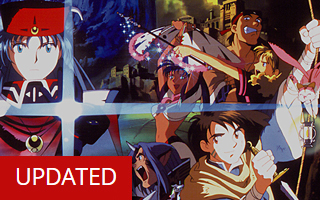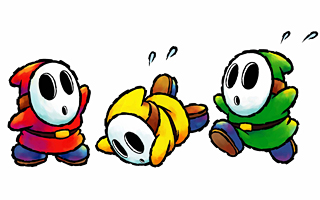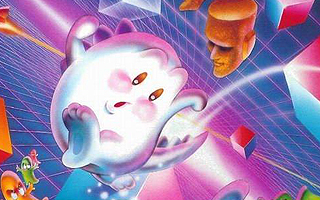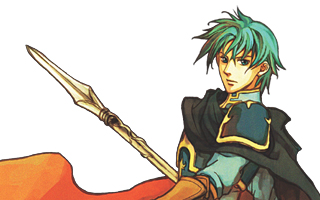Sharp X68000
Top 10 Best Sharp X68000 Games of All Time!
The Sharp X68000 was named for the Motorola 68000 CPU that it housed. This processor was previously used in the Atari ST and Amiga and would later be used in the Sega Genesis and Neo Geo, but the configuration used by Sharp was most similar to Capcom’s CPS arcade boards. The Sharp X68000 was far more advanced than most computers of its era and an ideal platform for arcade ports. Its $3000 price tag was a lot to swallow in 1987, but that didn’t prevent it from becoming a success. Despite being released exclusively in Japan, the X68000 found its way into 16 million homes.
10
Gradius II
1992

Gradius II was ported to the Famicom, PC-Engine, and X68000, but none of these versions made it out of Japan. It’s unfortunate, as Gradius II is one of the finest side-scrolling shooters of all time. The Gradius series is best-known for its innovative power-up system. During the game, players will find items that increase speed, add missiles, double their fire power, generate force fields, or create additional sentry pods to fight alongside them. Gradius II expands upon this concept by introducing new weapons and allowing the player to select their desired upgrades before each level. The game is also loaded with trademark Gradius randomness. One minute you’ll be flying through space blasting down enemy ships, and the next you’ll be trying to protect yourself from bizarre Easter Island statues. (I still haven’t figured out why there so many volcanoes in space.) The X68000 version is basically a direct port of the arcade original. It features new music and runs at a slightly lower resolution, but the differences are trivial. Gradius II is arguably the best game in the series and ranks right up there with the best X68000 shoot ’em ups.
9
Parodius Da!
1991

The Parodius games feature graphics, music, and gameplay elements that are intentionally absurd. As its name implies, Parodius is a parody of Gradius. (It also incorporates elements from Twinbee, Salamander, and other Konami games as well.) Parodius plays exactly like you’d expect a Gradius game to, and it even uses the same upgradable weapon system. Some may question the choice to rate a comedy game over the real thing, but I appreciate the sense of humor and variety that the game offers. The environments are lighthearted, but the game is still challenging in its own right. The graphics are overtly colorful, the scenarios are completely nonsensical, and the enemies are absolutely preposterous. Needless to say, there aren’t a lot of 2D shoot ’em ups that feature flying penguins, pandas in pink tutus, and enormous half-naked showgirls as enemies.
8
Final Fight
1992

The architecture of the X68000 was nearly identical to that of Capcom’s CPS-1 arcade board. This made it extremely easy to port many of Capcom’s classic arcade games to the system. Final Fight is a side-scrolling beat ’em up that was originally released in the arcades in 1989. The basic goal of the game is to beat up endless waves of street thugs and gang members in an effort to rescue a kidnapped girl. The best thing about Final Fight was the option to play as one of three characters. The husky pro-wrestler was the strongest, the modern-day Bushin ninja was the fastest, and the generic third character was the most balanced. Final Fight was ported to over a dozen gaming platforms, but the X68000 version was easily the best home port of its day. The SNES version only featured two characters and dropped the two-player co-op feature. The Sega CD version was much better, but the colors were washed out. The X68000 port didn’t feature as many enemies on screen as the arcade version did, but this actually made the game more approachable.
7
Aquales
1991

The easiest way to describe Aquales is “Cybernator meets Bionic Commando.” The game involves a giant robot who uses a grappling beam to move from one platform to another. The robot has a dozen or so weapons to find in the game’s eight stages, but the grappling beam is the star of the show. The game’s developer (Exact) didn’t exactly have the same pedigree as Konami or Capcom, but the production values in Aquales were top notch. The game featured some nice parallax scrolling and transparency effects, and it also had one of the best opening cutscenes of its era. The X68000 had a strong library of games, but it was severely lacking when it came to exclusives. The system had a number of porny RPGs and quirky simulations like Prostitute Maker, but it’s not too much of a stretch to suggest that many of its best games were arcade ports. Aquales has the distinction of being the best game released exclusively on the X68000. On that note, you could argue that Aquales is the best reason to own the system.
6
R-Type
1989

R-Type is a side-scrolling shooter that was originally released in the arcades in 1987. The pacing in R-Type is more methodical than most shooters from the era, and players will have to memorize enemy attack patterns if they want to advance rather than relying on reflexes alone. This strategic aspect overflows into every facet of the game. For instance, the option of holding down the fire button to charge up your primary weapon can become an exercise in risk management. Players will ultimately have to decide when they can take the time to power up and when they should rapidly fire away at the onslaughts of enemy fighters. One of R-Type‘s trademarks is the special force pods that fly around your ship acting as robotic wingmen. These force units can also be attached to the front or back of your ship to provide extra firepower or protection. Knowing where and when to position these force units can require meticulous planning. It’s no wonder R-Type is often described as “the thinking man’s shooter.” R-Type was one of the best looking arcade games of its day, with the massive screen-filling bosses being particularly impressive. The X68000 is a near-perfect port.
5
Ghouls ‘n Ghosts
1988

Ghouls ‘n Ghosts is another CPS-1 game from Capcom and the sequel to Ghosts ‘n Goblins. The game improved upon its predecessor in many ways. The sprites were larger, the graphics were more detailed, and the overall art direction was more sophisticated than what was seen in typical 8-bit games. From the sneaky skeletons that jump out of the background to the large bosses that are found in every stage, the variety of enemies that the game throws your way was very impressive. Ghouls ‘n Ghosts was the crown jewel in the Genesis’ launch lineup and effectively welcomed gamers to the “next level” by bringing the arcade experience home. The X68000 version was an even better port and basically a pixel-for-pixel conversion. It was nice for Capcom to give X68000 owners the option of choosing from one of eight difficulty settings. The game is still quite challenging even on the “very easy” setting, but it makes the experience somewhat less frustrating.
4
Strider
1991

Strider is arguably the greatest arcade game of the late ’80s. What’s not to love about a futuristic ninja who can climb walls, walk on ceilings, and slash people with a plasma sword? The game is filled with one memorable moment after another. Throughout the course of the adventure, players will encounter a giant robotic gorilla, battle futuristic sky pirates, and hitch a ride on a dinosaur’s back. It’s a relatively short game, but it’s hard not to be impressed with its variety. Every stage offered something completely different. The Sega Genesis version received high praise in 1990 and was even named Game of the Year by Electronic Gaming Monthly (over Super Mario Bros. 3, no less!) Like most Capcom CPS-1 arcade games, the X68000 port was extremely faithful to the original. It was vastly superior to the PC-Engine version and even better than the iconic Genesis version.
3
Downtown Nekketsu Story
1990

It has been said already, but most of the best games on the X68000 were ports of arcade games. This isn’t a bad thing, but it’s fair to say that there are certain advantages to designing games specifically for home audiences. A game like Downtown Nekketsu Story is a game that wasn’t meant to be completed in a single session. Gaining experience points, learning new moves, and the frequent need to backtrack would have made the game a little too complex for arcades. Downtown Nekketsu Story was originally developed for the Famicom (and released in the West as River City Ransom), but the X68000 features an expanded world and more branching pathways. Some of the techniques that could only be used by enemy characters in the Famicom version (including a diving headbutt and a whirlwind kick) can be learned by the player in the X68000 version! It’s just unfortunate that the developers didn’t make an effort to use the extra horsepower that the system offered. The game doesn’t really look any better than the Famicom version, and navigating through the new areas can be a little confusing due to repetitive backgrounds. If the game got a 16-bit visual update, it may have ranked even higher on this list.
2
Akumajou Dracula
1993

Akumajou Dracula is better known to American gamers as Castlevania, and the X68000 version is an enhanced port of the original Famicom game. The game featured improved graphics, a new intro, and an amazing soundtrack that included remixed tunes and a handful of new songs. It also gave players more control over their character, and the ability to whip diagonally made the game feel a lot less rigid. Although the game featured a couple of brand new areas that weren’t in the Famicom version, many of the layouts were carried over and the gameplay felt remarkably similar to the original. This is a good thing because the first Castlevania is still the purest game in the series. Castlevania III featured multiple characters to play and Symphony of the Night borrowed exploration elements from Super Metroid, but these additions made the games somewhat less challenging. In the original Castlevania, every obstacle needed to be approached head on. There were fewer ways to dispatch enemies, so players had to completely master the limited repertoire they had. Castlevania was an instant classic on the NES, but the X68000 version is even better.
1
Super Street Fighter II
1994

Street Fighter II is the most important game of the 16-bit era, and the X68000 wouldn’t have been complete without it. The game ushered in the fighting game craze of the early ’90s and still stands as one of the best games in the genre. Like other Capcom games on this list, the X68000 version was nearly identical to the arcade original. Capcom even released a special adapter that would allow gamers to use the Capcom Fighter Power Stick controller. (This adapter also let them use any Super Famicom or Mega Drive game pad.) Super Street Fighter II was the fourth major arcade iteration of the game and the third version released on the X68000. With 16 playable characters, the Super update had a roster that was twice as large as the original release. It also added new moves and better backgrounds. Super Street Fighter II was the first game developed for Capcom’s CPS-2 arcade board, but the background music in the X68000 version was more in line with what you would expect form the CPS-1. It’s still the most accurate 16-bit version of the game ever released and the only one with the back-up animations in tact. It might be boring to see a Street Fighter game top yet another list, but the game is deserving of the praise.





Do you agree with this list? Let us know what you think by leaving a comment below. Your opinion matters!